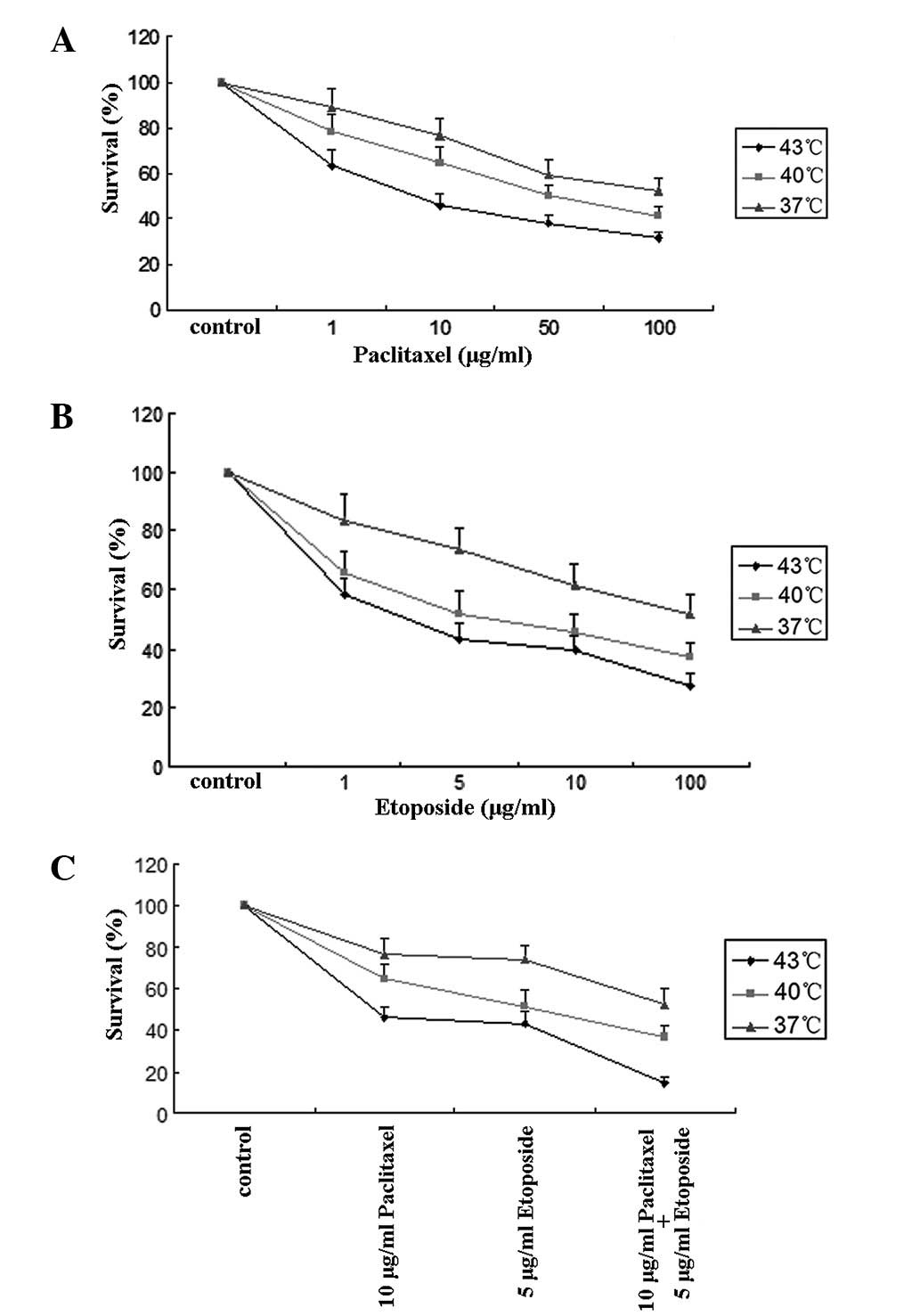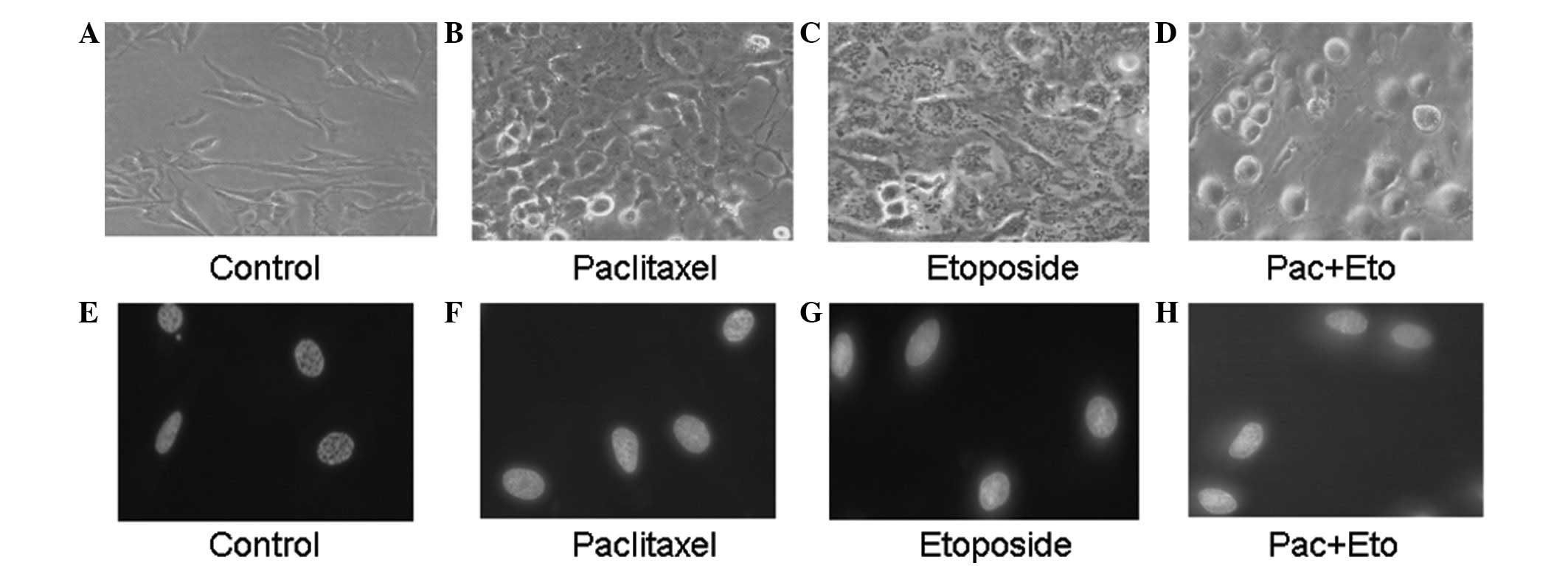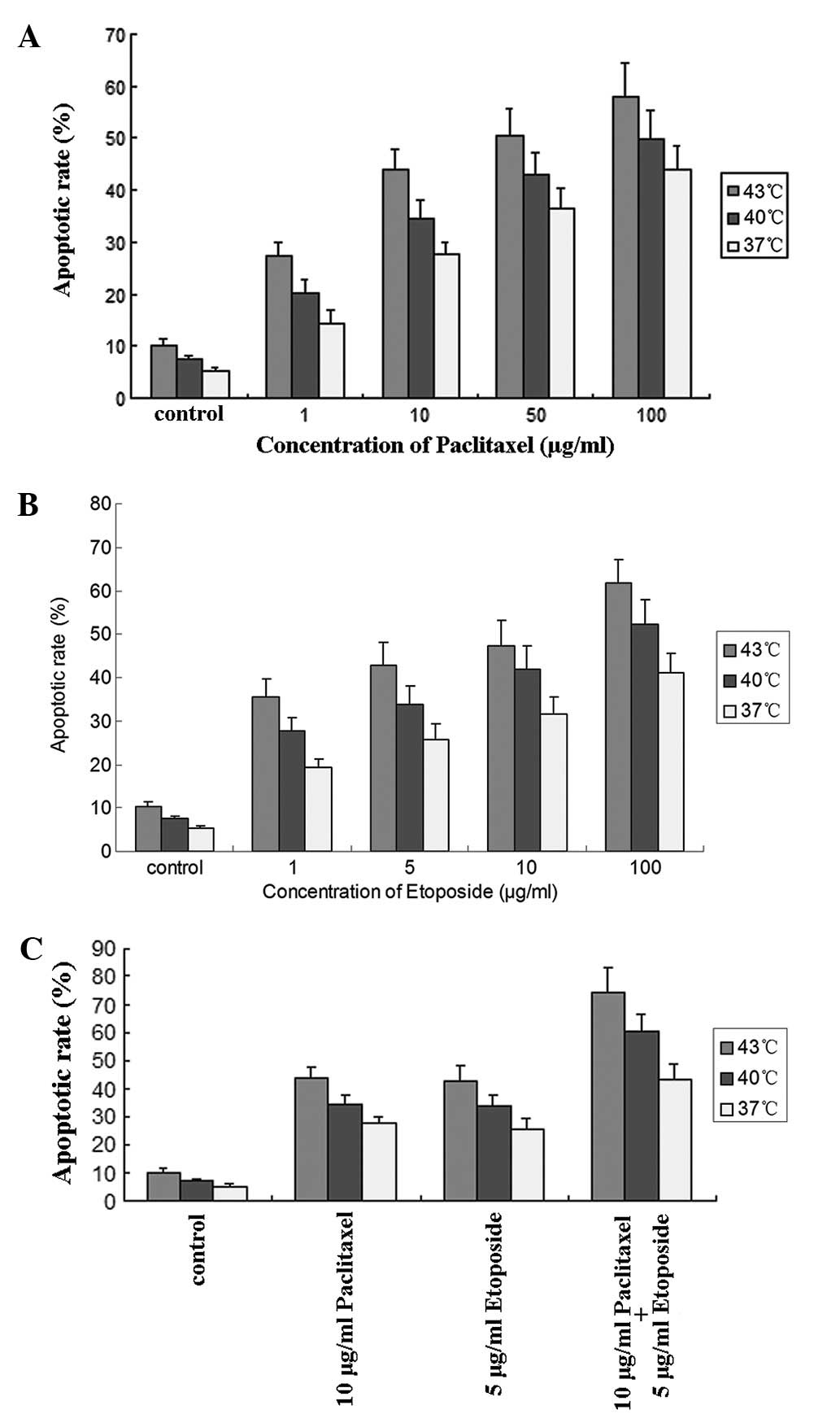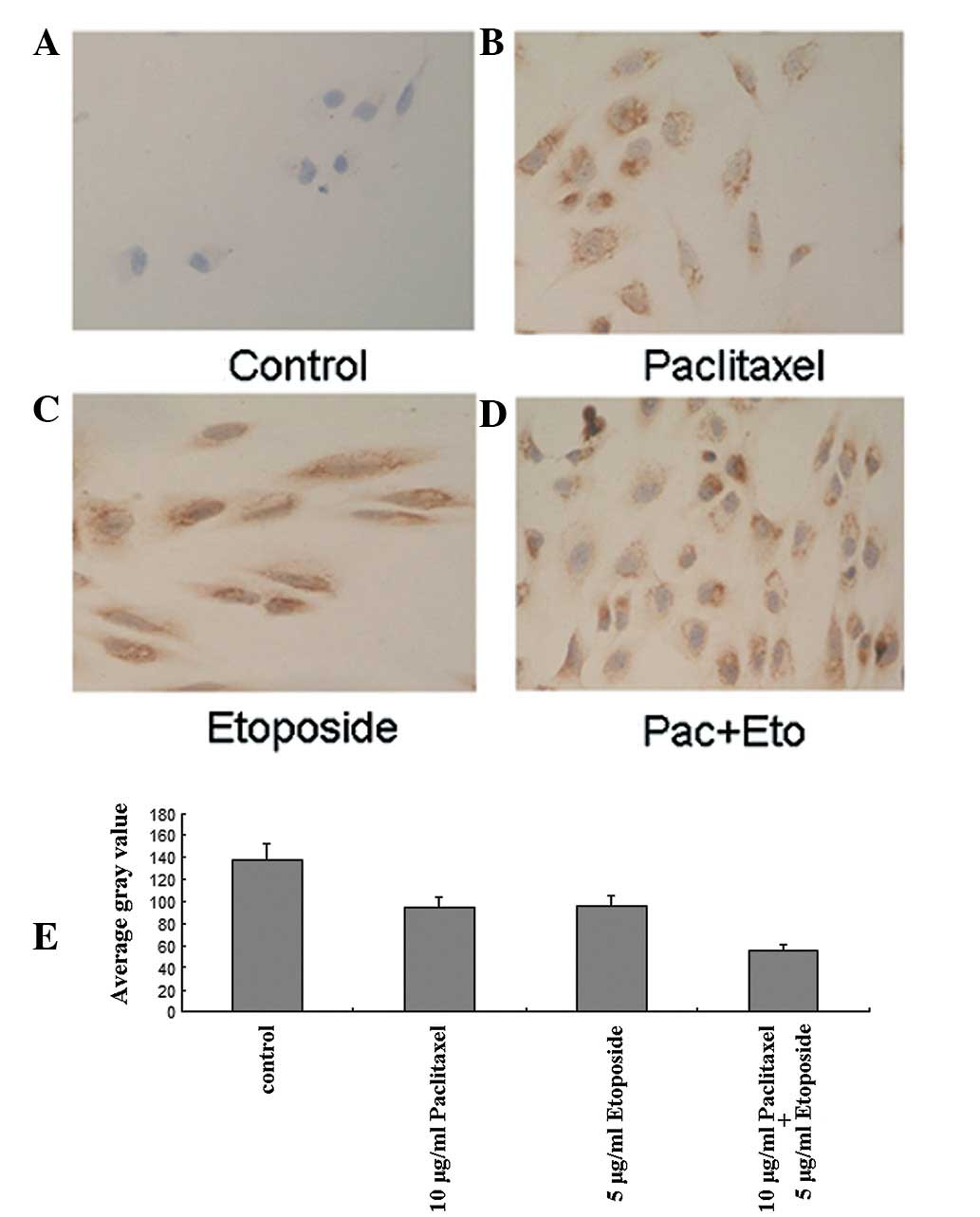Synergistic increase in the sensitivity of osteosarcoma cells to thermochemotherapy with combination of paclitaxel and etoposide
- Authors:
- Published online on: September 3, 2012 https://doi.org/10.3892/mmr.2012.1058
- Pages: 1013-1017
Abstract
Introduction
Osteosarcoma is an aggressive malignant neoplasm with poor prognosis. The use of local excision of the tumor tissue with limb salvage surgery combined with neoadjuvant chemotherapy has improved the survival rate markedly (1,2). However, the local excision is not always complete, which triggers recurrence at the primary site, leading to treatment failure (3,4). Local perfusion thermochemotherapy has long been proposed as an anticancer treatment, specifically for the prevention of local recurrence, for use in combination with surgery and chemotherapy (5–7). It has been shown that, at high temperatures, chemotherapeutic drugs kill the osteosarcoma tumor tissue that has not been removed by surgery, thereby reducing recurrence at the primary site (8,9).
Our laboratory has focused on identifying strategies for improving the thermochemotherapeutic effect of etoposide on osteosarcoma. We hypothesized that the combination of paclitaxel and etoposide in the presence of hyperthermia is likely to have an improved killing effect on osteosarcoma cells. The purpose of this study was to evaluate the cytotoxic effects of a combination of paclitaxel and etoposide on an osteosarcoma cell line in the presence of hyperthermia and investigate the effects of the combination on the Fas-associated death receptor pathway.
Materials and methods
Materials
The OS732 osteosarcoma cell line was bought from Beijing Jishuitan Hospital and the RPMI-1640 powder was acquired from Gibco-BRL (Carlsbad, CA, USA). Trypsin, MTT and RNase A were acquired from Huamei Biological Co. (Beijing, China). The following materials were also used: paclitaxel (Beijing Concord Pharmaceutical, Beijing, China), etoposide (Hisun Pharmaceutical Co., Zhejiang, China), an enzyme meter (Bio-Rad, Hercules, CA, USA), a FACScan flow cytometer (Becton-Dickinson, Franklin Lakes, NJ, USA), an LH50A inverted phase contrast microscope (Olympus, Tokyo, Japan) and a fluorescence microscope (Nikon, Tokyo, Japan).
Cell culture and research methods
The OS732 osteosarcoma cell line was added to RMPI-1640 solution with 10% fetal bovine serum and cultured in an incubator at 37°C in a humidified 5% CO2 atmosphere. The cells that had entered the logarithmic growth phase were selected and heated using a numerical display constant temperature (±0.1°C) water bath, set at various temperatures (37, 40 and 43°C) for 1 h. We selected concentrations of 1, 10, 50 and 100 μg/ml for the paclitaxel group, 1, 5, 10 and 100 μg/ml for the etoposide group and 10 μg/ml paclitaxel with 5 μg/ml etoposide for the combination group. PBS was used for the blank control group. These concentrations were selected on the basis of EC50 doses that we established in a preliminary trial. All trials were repeated four times. The study was approved by the ethics committee of China Medical University.
Measurement of the survival rates of tumor cells by the MTT method
The treated cells (5×105/ml) were seeded in a 96-well plate with a 200 μl reaction volume per well, using 4 parallel wells per group. After culturing for 24 h, freshly prepared 5 mg/ml MTT was added to each well and incubation was continued at 37°C for 4 h. The supernatant was then discarded and 150 μl DMSO was added. The absorbance (A) was measured at 540 nm. The survival rate of the tumor cells (%) = Aexperimental group/Acontrol group × 100.
Observation of the morphology of apoptotic cells
The morphology, number and adherence of the tumor cells were directly observed using an inverted phase contrast microscope. A cover slide was placed in a 6-well plate, seeded with OS732 cells, fixed for 10 min and stained with 0.5 ml Hoechst 33258 staining solution for 5 min. Images were then captured using a fluorescence microscope.
Measurement of the proportion of apoptotic cells by flow cytometry (FCM)
The digested cells were collected, washed with PBS, centrifuged and then treated with 70% cold ethanol to fix overnight. The cells were then centrifuged to remove ethanol and washed twice with PBS. The cells were stained in the dark with 100 μl PI staining solution at 4°C for 1 h. The strength of the fluorescence was measured using a FACScan flow cytometer. The wavelength of the activating light was 488 nm, and the apoptotic rates were measured using CellQuest analysis software.
Immunocytochemistry to detect Fas expression in OS732 cells
Digested cells (2×105/ml) were placed in a 6-well culture plate with a pre-treated cover slide in each well. After culturing for 24 h, the supernatants were discarded, the drug or drug combination was added and culturing was continued for 24 h. A blank control group was also established. The cover slides were removed, fixed with acetone at 4°C for 10 min and stained by the SP method. A brown-yellow cytoplasm indicated a Fas-positive cell, and the expression levels of Fas were determined from the average gray levels obtained using a micro-picture analysis system.
Statistic method
Experimental data are the mean ± SD. Comparisons among groups were made by ANOVA, and for any two groups, a t-test was used for statistical analysis. P<0.05 was considered to indicate a statistically significant result. All results were analyzed using Windows SPSS 15.0 software.
Results
Changes in the survival rates of the tumor cells for the three thermochemotherapeutic drug treatments
Following the treatment of the OS732 cells at various temperatures for 1 h with paclitaxel at concentrations of 1, 10, 50 and 100 μg/ml, the cell growth was inhibited in a dose-dependent manner and there were significant differences between the groups (P<0.05; Fig. 1A). Similarly, when etoposide was used at concentrations of 1, 5, 10 and 100 μg/ml, the cell growth also varied between the groups (P<0.05; Fig. 1B). For the combination of 10 μg/ml paclitaxel and 5 μg/ml etoposide, the survival rate was significantly lower (P<0.01; Fig. 1C) than for either 10 μg/ml paclitaxel or 5 μg/ml etoposide alone, showing that the combination of paclitaxel and etoposide has a stronger inhibitory effect than either single agent. More significantly, we found that the cell growth was inhibited in a temperature-dependent manner since the survival rates of the OS732 cells were lowest at 43°C and highest at 37°C.
Morphological changes of apoptosis in OS732 cells
Under an inverted phase contrast microscope, the normal OS732 cells were observed to be attached to the dish; the cells were rhomboid and angular and were growing adhered to the dish (Fig. 2A). Following the application of either paclitaxel (10 μg/ml) or etoposide (5 μg/ml), certain parts of the cells became small and round (Fig. 2B and C) whereas following the combined application, chromatin and cytoplasm condensation occurred and numerous cells exfoliated and were suspended in the culture medium (Fig. 2D). Using a fluorescence microscope, lightly-stained control OS732 cells were observed (Fig. 2E). Following the application of either paclitaxel (10 μg/ml) or etoposide (5 μg/ml), only parts of the cells demonstrated condensed and flared fluorescence (Fig. 2F and G) whereas, following the combined application, condensed and flared fluorescence was clearly observed, revealing the presence of numerous apoptotic cells (Fig. 2H).
Comparison of the apoptotic rates in OS732 cells for various medication methods by FCM
Following the treatment of the cells at various temperatures for 1 h with paclitaxel at concentrations of 1, 10, 50 and 100 μg/ml, the apoptotic rate increased in a dose-dependent manner and there were significant differences between the groups (P<0.05; Fig. 3A). For etoposide concentrations of 1, 5, 10 and 100 μg/ml, the apoptotic rate also increased in a dose-dependent manner, and there were significant differences between groups (P<0.01; Fig. 3B). For the combination of 10 μg/ml paclitaxel and 5 μg/ml etoposide, the apoptotic rate was significantly higher (P<0.01; Fig. 3C) than for 10 μg/ml paclitaxel or 5 μg/ml etoposide alone, indicating that the combined use of paclitaxel and etoposide has a stronger apoptosis-inducing effect than the use of either individually.
Fas expression in OS732 cells by immunocytochemistry
We observed only a small number of brown particles in the cytoplasms of the control OS732 cells (Fig. 4A). Deeper staining of the cytoplasms was observed following treatment with 10 μg/ml paclitaxel (Fig. 4B) or 5 μg/ml etoposide (Fig. 4C). For cells treated with a combination of 10 μg/ml paclitaxel and 5 μg/ml etoposide, the cytoplasms were stained much more strongly; staining was observed in the entire field of vision (Fig. 4D). We further measured the Fas levels quantitatively using a MetaMorph automatic image analyzer to compare the average gray values, which are inversely proportional to the levels of Fas expression (Fig. 4E)
Discussion
Thermochemotherapy is a comprehensive method that has been developed based on the hyperthermal therapy of malignant tumors. The isolated perfused chemotherapy of osteosarcoma hyperthermally may not only effectively control the primary local tumor, but also greatly increase the rate of successful limb salvage (6,8). Although the efficacy of thermotherapy with etoposide has been extensively demonstrated in a number of tumor tissues (10–12), there are only limited studies available in the field of osteosarcoma. It is well known that the optimal therapeutic temperature clinically is 42–43°C for 1 h (10) as this maximizes the tumor damage while preserving the surrounding normal tissue. We also found that 43°C is the ideal temperature for a combination of paclitaxel and etoposide to kill the OS732 cell lines in thermochemotherapy.
In the current study, we found that following the use of etoposide or paclitaxel at various temperatures for 1 h, the proliferation of tumor cells was inhibited in a dose-dependent manner, indicating that each drug had a characteristic thermotherapy-enhanced effect (Fig. 1A and B). From observation of the morphological changes in the apoptotic cells by inverted phase contrast microscopy (Fig. 2B and C) and by fluorescence microscopy (Fig. 2F and G), we deduced that paclitaxel and etoposide induced apoptosis in the osteosarcoma cells. Assessment of the proportion of apoptotic cells by FCM (Fig. 3A and B) revealed that the killing effect on OS732 cells was due to the induction of apoptosis.
Currently, there is a consensus on the enhancing effect of thermotherapy on etoposide (10–12), and positive views on the enhancing effect of thermotherapy on paclitaxel have been reported (13–15). However, there are also contrary opinions; Mohamed et al reported that the cytotoxicity of docetaxel is enhanced by hyperthermia whereas that of paclitaxel is not (16).
We found that following the joint application of low doses of paclitaxel and etoposide to OS732 cells at 43°C for 1 h, the cell survival rates decreased sharply compared with those treated individually with paclitaxel or etoposide (Fig. 1C), demonstrating that the combined use of paclitaxel and etoposide has a stronger inhibitory effect. We also found apoptotic changes in the combination group when observing the cells under an inverted phase contrast microscope (Fig. 2D) as well as with a fluorescence microscope (Fig. 2H). The apoptotic rates in the combination group were clearly higher (P<0.01) than in the individual treatment groups, indicating that the inhibitory effect on the tumor cells was predominantly accomplished by the induction of apoptosis (Fig. 3C), in agreement with studies in other tumors (17).
There are two accepted theories concerning the antitumor mechanism of thermochemotherapy. Firstly, thermotherapy may alter the membranes of the tumor cells and thereby enable the drugs to enter the tumor cells more easily (18). Secondly, thermotherapy may promote the ability of the drugs to induce apoptosis in the tumor cells. A number of chemotherapeutic agents induce cellular apoptosis by various mechanisms which may be promoted by thermotherapy. Our study indicates that, under hyperthermal conditions, paclitaxol and etoposide each individually increased Fas expression levels compared with the control group; however, the combination of paclitaxel and etoposide greatly increased the Fas expression levels in the OS732 cells compared with the individual treatments (Fig. 4).
Previous studies have revealed that Fas-FADD signaling is critical in the induction of apotosis in tumor cells by etoposide (19–21). Our results are essentially consistent with those of previous studies. As for the antitumor mechanism of paclitaxel, it is primarily regarded to be the induction of cell accumulation in the G2/M phase of the cell cycle (22). Certain studies have revealed that Fas-FADD signaling is also influential in the induction of apoptosis in tumor cells by paclitaxel (23,24). It has also been reported that paclitaxel triggers cell death in H460 cells via an unidentified caspase-independent mechanism (25). Our results reveal that paclitaxel increases the expression levels of Fas in OS732 cells; however, we should not neglect the possibility that hyperthermia is also involved in the upregulation of Fas expression since previous studies have indicated that hyperthermia affects Fas levels (26,27). We found that, in the presence of hyperthermia, small doses of paclitaxel and etoposide synergistically contributed to the upregulation of Fas, which we reveal is the probable mechanism by which paclitaxel acts in the thermochemotherapy of osteosarcoma. Since local thermal etoposide infusion chemotherapy has been widely used clinically, we expect that the upregulation of Fas is likely to help to improve the sensitivity of the osteosarcoma cells to thermochemotherapy with etoposide and maximize the cytotoxic effects on the primary tumor so as to prevent recurrence following surgery.
In conclusion, our results demonstrate that paclitaxel is capable of sensitizing the OS732 cell line to etoposide in the presence of hyperthermia by upregulation of Fas expression. Paclitaxel is commonly used in cancer treatment (28,29). However, we consider that the use of paclitaxel in the thermochemotherapy of osteosarcoma would be a more suitable therapeutic method. Since etoposide and paclitaxel are antitumor drugs with specific therapeutic effects, toxicity and resistance may readily occur following their large-dose and long-term use, whereas the combined application of small doses of etoposide and paclitaxel in the presence of hyperthermia is likely to enhance the apoptosis-inducing effect, resulting in improved drug sensitivity in osteosarcoma patients and minimizing the cytotoxicity caused by clinical chemotherapy.
In this study, the combined application of 10 μg/ml paclitaxel and 5 μg/ml etoposide to OS732 cells in the presence of hyperthermia greatly inhibited the OS732 cells by inducing apoptosis more strongly than the application of 10 μg/ml paclitaxel or 5 μg/ml etoposide alone. Paclitaxel enhances the thermochemotherapy of osteosarcoma cell lines and this is primarily accomplished by the upregulation of Fas expression and the induction of apoptosis.
Acknowledgements
This article was checked by Dr Shavali Shaik of Beth Israel Deaconess Medical Center, Harvard Medical School.
References
|
Bacci G, Balladelli A, Palmerini E, et al: Neoadjuvant chemotherapy for osteosarcoma of the extremities in preadolescent patients: the Rizzoli Institute experience. J Pediatr Hematol Oncol. 30:908–912. 2008. | |
|
Bacci G, Rocca M, Salone M, et al: High grade osteosarcoma of the extremities with lung metastases at presentation: treatment with neoadjuvant chemotherapy and simultaneous resection of primary andmetastatic lesions. J Surg Oncol. 98:415–420. 2008. | |
|
Franke M, Hardes J, Helmke K, et al: Solitary skeletal osteosarcoma recurrence. Findings from the Cooperative Osteosarcoma Study Group. Pediatr Blood Cancer. 56:771–776. 2011. | |
|
Andreou D, Bielack SS, Carrle D, et al: The influence of tumor- and treatment-related factors on the development of local recurrence in osteosarcoma after adequate surgery. An analysis of 1355 patients treated on neoadjuvant Cooperative Osteosarcoma Study Group protocols. Ann Oncol. 22:1228–1235. 2011. | |
|
Routt SM, Zhu J, Zaleski JM and Dynlacht JR: Potentiation of metalloenediyne cytotoxicity by hyperthermia. Int J Hyperthermia. 27:435–444. 2011. | |
|
Streckfus CF, Brown RE and Bull JM: Proteomics, morphoproteomics, saliva and breast cancer: an emerging approach to guide the delivery of individualised thermal therapy, thermochemotherapy and monitor therapy response. Int J Hyperthermia. 26:649–661. 2010. | |
|
Trieb K, Blahovec H and Kubista B: Effects of hyperthermia on heat shock protein expression, alkaline phosphatase activity and proliferation in human osteosarcoma cells. Cell Biochem Funct. 25:669–672. 2007. | |
|
Fan QY, Ma BA, Zhou Y, et al: Bone tumors of the extremities or pelvis treated by microwave-induced hyperthermia. Clin Orthop Relat Res. 406:165–175. 2003. | |
|
Shido Y, Nishida Y, Suzuki Y, et al: Targeted hyperthermia using magnetite cationic liposomes and an alternating magnetic field in a mouse osteosarcoma model. J Bone Joint Surg Br. 92:580–585. 2010. | |
|
Vujaskovic Z, Kim DW, Jones E, et al: A phase I/II study of neoadjuvant liposomal doxorubicin, paclitaxel, and hyperthermia in locally advanced breast cancer. Int J Hyperthermia. 26:514–521. 2010. | |
|
Tang Y and McGoron AJ: Combined effects of laser-ICG photothermotherapy and doxorubicin chemotherapy on ovarian cancer cells. J Photochem Photobiol B. 97:138–144. 2009. | |
|
Fiorillo A, DeRosa G, Giugliano F, et al: Efficacy of pegylated lyposomal anthracyclines and of intra-arterial carboplatin and doxorubicin combined with local hyperthermia in a case of malignant endovascular papillary angioendothelioma. Curr Drug Deliv. 6:58–61. 2009. | |
|
Liu B, Yang M, Li X, et al: Enhanced efficiency of thermally targeted taxanes delivery in a human xenograft model of gastric cancer. J Pharm Sci. 97:3170–3181. 2008. | |
|
Michalakis J, Georgatos SD, de Bree E, et al: Short-term exposure of cancer cells to micromolar doses of paclitaxel, with or without hyperthermia, induces long-term inhibition of cell proliferation and cell death in vitro. Ann Surg Oncol. 14:1220–1228. 2007.PubMed/NCBI | |
|
Zoul Z, Filip S, Melichar B, et al: Weekly paclitaxel combined with local hyperthermia in the therapy of breast cancer locally recurrent after mastectomy - a pilot experience. Onkologie. 27:385–388. 2004. | |
|
Mohamed F, Marchettini P, Stuart OA, et al: Thermal enhancement of new chemotherapeutic agents at moderate hyperthermia. Ann Surg Oncol. 10:463–468. 2003. | |
|
de Bree E, Theodoropoulos PA, Rosing H, et al: Treatment of ovarian cancer using intraperitoneal chemotherapy with taxanes: from laboratory bench to bedside (Review). Cancer Treat Rev. 32:471–482. 2006. | |
|
de Bree E, Rosing H, Michalakis J, et al: Intraperitoneal chemotherapy with taxanes for ovarian cancer with peritoneal dissemination (Review). Eur J Surg Oncol. 32:666–670. 2006. | |
|
Miyata S, Takemura G, Kosai K, et al: Anti-Fas gene therapy prevents doxorubicin-induced acute cardiotoxicity through mechanisms independent of apoptosis. Am J Pathol. 176:687–698. 2010. | |
|
Kim HS, Lee YS and Kim DK: Doxorubicin exerts cytotoxic effects through cell cycle arrest and Fas-mediated cell death. Pharmacology. 84:300–309. 2009. | |
|
Li S, Zhou Y, Dong Y and Ip C: Doxorubicin and selenium cooperatively induce Fas signaling in the absence of Fas/Fas ligand interaction. Anticancer Res. 27:3075–3082. 2007. | |
|
Drago-Ferrante R, Santulli A, Di Fiore R, et al: Low doses of paclitaxel potently induce apoptosis in human retinoblastoma Y79 cells by up-regulating E2F1. Int J Oncol. 33:677–687. 2008.PubMed/NCBI | |
|
Pires NM, Eefting D, de Vries MR, et al: Sirolimus and paclitaxel provoke different vascular pathological responses after local delivery in a murine model for restenosis on underlying atherosclerotic arteries. Heart. 93:922–927. 2007. | |
|
Stumm S, Meyer A, Lindner M, et al: Paclitaxel treatment of breast cancer cell lines modulates Fas/Fas ligand expression and induces apoptosis which can be inhibited through the CD40 receptor. Oncology. 66:101–111. 2004. | |
|
Huisman C, Ferreira CG, Bröker LE, et al: Paclitaxel triggers cell death primarily via caspase-independent routes in the non-small cell lung cancer cell line NCI-H460. Clin Cancer Res. 8:596–606. 2002. | |
|
Wang X, Gao XH, Li X, et al: Local hyperthermia induces apoptosis of keratinocytes in both normal skin and condyloma acuminata via different pathways. Apoptosis. 14:721–728. 2009. | |
|
Yu DY, Matsuya Y, Zhao QL, et al: Enhancement of hyperthermia-induced apoptosis by a new synthesized class of furan-fused tetracyclic compounds. Apoptosis. 12:1523–1532. 2007. | |
|
Ohguri T, Imada H, Narisada H, et al: Systemic chemotherapy using paclitaxel and carboplatin plus regional hyperthermia and hyperbaric oxygen treatment for non-small cell lung cancer with multiple pulmonary metastases: preliminary results. Int J Hyperthermia. 25:160–167. 2009. | |
|
Hulshof MC, Van Haaren PM, Van Lanschot JJ, et al: Preoperative chemoradiation combined with regional hyperthermia for patients with resectable esophageal cancer. Int J Hyperthermia. 25:79–85. 2009. |













